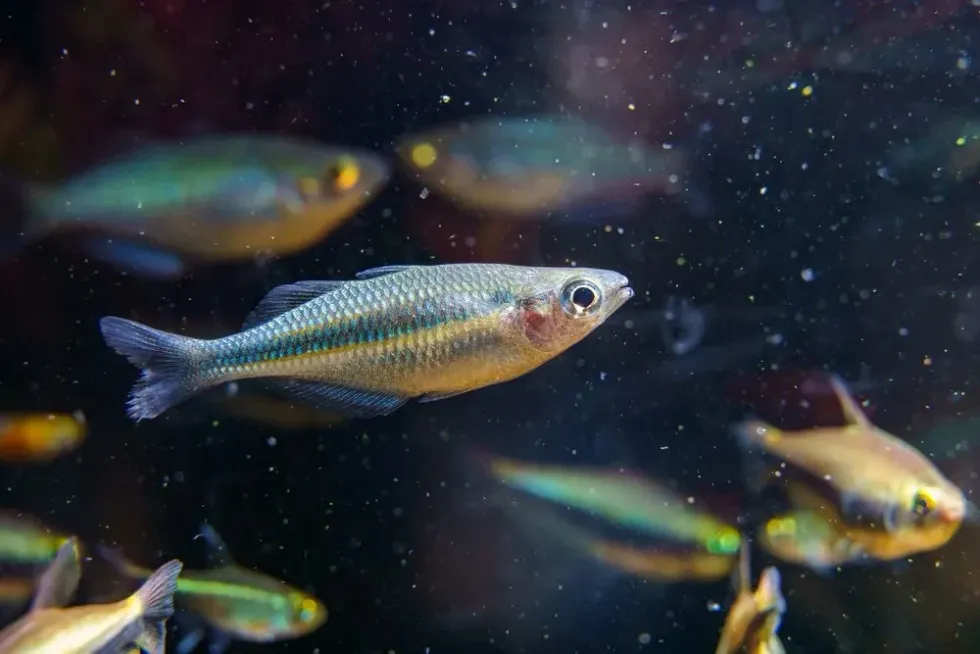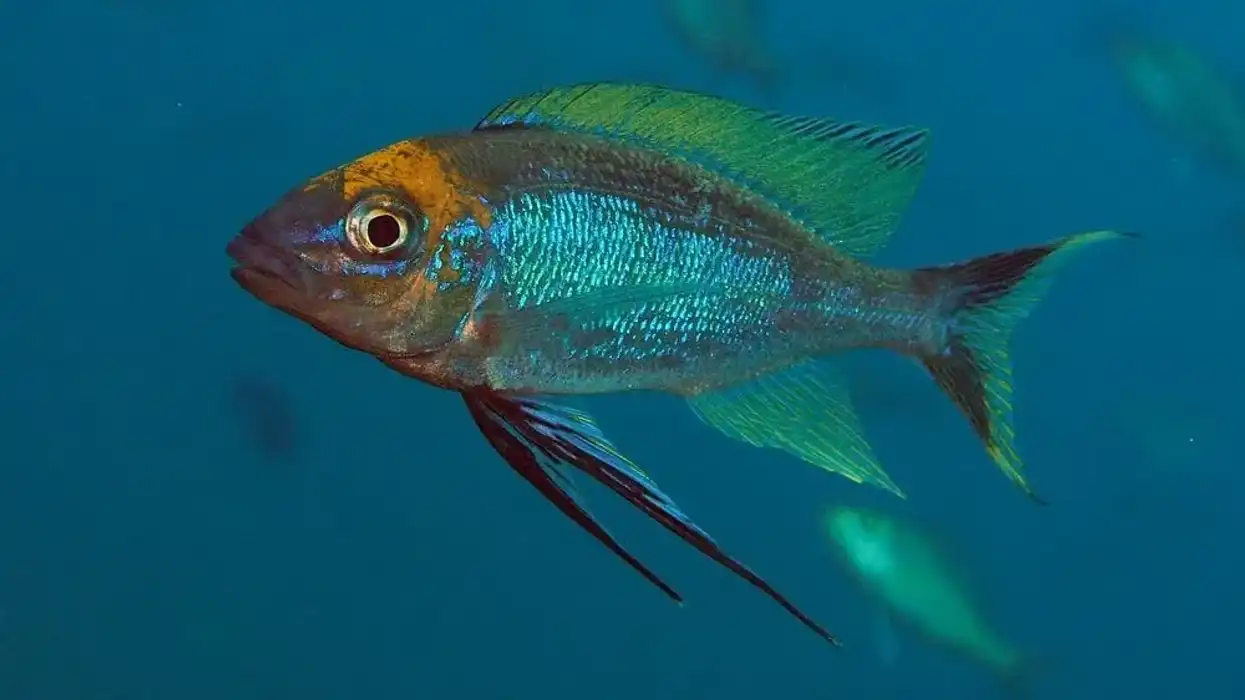The turquoise rainbowfish (Melanotaenia lacustris) is a fish species endemic to Lake Kutubu and Soro River in Papua New Guinea. This species of fish belongs to the family of Melanotaeniidae. This turquoise rainbowfish is also known by the name of Lake Kutubu rainbowfish.
The name, Lake Kutubu rainbowfish, is given as their only habitat is in Lake Kutubu in Papua New Guinea. This rainbowfish species is a community fish species that can beautify community aquarium tank habitats. They have always been popular as pets and aquarium tank fishes.
The turquoise rainbowfish habitat consists of the freshwater highland lake areas in Lake Kutubu and the lake's outlet stream called the Soro River. Lake Kutubu is in the Kikori River system.
Lake Kutubu rainbowfish are one of the most popular pet fish kept in an aquarium tank and have been seen in many parts of the world.
This schooling fish species are active swimmers and do really well in a planted tank. The brilliantly colored fish keeps the beauty of the aquarium tank alive with their coloration and prolific nature.
A minimum tank size of 55 gal (208.1 L) is needed for the fish to roam freely and live naturally. The water conditions needed are a pH 7.0 - 9.0, temperature of 68-77 F (20-25 C), and a tank size of 55 gal (208.1 L) for six or eight schooling fishes.
Adding some plants and substrate to keep free spaces for the fish to roam inside the tank can work wonders.
Other fish species are also compatible with these rainbows. The average purchase size of this tropical fish is 2 in (5 cm).
For more relatable content, check out these channel catfish facts and rockfish facts for kids.
Turquoise Rainbowfish Interesting Facts
What type of animal is a turquoise rainbowfish?
The blue turquoise rainbowfish is a species of fish of the family Melanotaeniidae. This is a popular breed and the owner typically gives them to tropical fish enthusiasts after the fry turns into juveniles.
What class of animal does a turquoise rainbowfish belong to?
The turquoise rainbowfish (Melanotaenia lacustris) falls under the class of Actinopterygii in the kingdom of Animalia.
How many turquoise rainbowfish are there in the world?
The population of Lake Kutubu rainbowfish, also known by the name turquoise rainbowfish or blue rainbowfish, is not known. Found in only a handful of areas, the extent of occurrence is very limited with just an area of 533.9 sq mi (1383 sq km).
The population is threatened due to various habitat destruction activities by humans. However, the fish is commonly kept on display in many community aquarium tanks.
Where does a turquoise rainbowfish live?
Lake Kutubu rainbowfish are found exclusively in Lake Kutubu and the Soro River. The Soro River is the outlet stream of the lake and these rainbows are endemic to Papua New Guinea.
What is a turquoise rainbowfish's habitat?
These rainbows are found in the freshwater highland lake of the region and are endemic to the Kikori River drainage of the Southern Highlands.
Who do turquoise rainbowfish live with?
It is a schooling fish and is found always in a school. A turquoise rainbowfish school size is around five or more fishes in a tank with plants. This school is divided into males and females to facilitate breeding and spawning. Even in the wild, rainbows are found in a school.
How long does a turquoise rainbowfish live?
The lifespan of turquoise rainbowfish is around five to eight years when living in captivity. The life expectancy in the wild is not known. These rainbow fishes are captive-bred and the owner of the fry supplies them to buyers when they are in the juvenile stage.
How do they reproduce?
The turquoise rainbow (Melanotaenia lacustris) is oviparous and is an egg-laying rainbow fish. Eggs are fertilized externally in the water and the females scatter the eggs in the water after laying.
The spawning females are known to lay around 100-200 eggs and these eggs are laid in a matter of several days. Eggs get stuck to water plants and depending on the temperature, eggs laid by the turquoise rainbowfish female hatches after 6-10 days.
This is why plants are important in the tank for rainbow fish. Once a pair is identified, breeding is fairly easy.
A young turquoise rainbowfish is free-swimming 24 hours later. The fry should be fed crushed flake food until they grow enough to feed on baby brine shrimp.
What is their conservation status?
The conservation status of the rainbow fish is categorized as Endangered by the IUCN Red List. The restricted range, oil and gas drilling around the lake leading to killings, diseases, parasites, and population have contributed to this status.
A rainbow fish is also commonly found in a 55 gal (208.1 L) planted aquarium around the world in addition to its home stretch in Papua New Guinea.
Turquoise Rainbowfish Fun Facts
What do turquoise rainbowfish look like?
The turquoise rainbowfish (Melanotaenia lacustris) has a rounded body, normal fins, and tail size common to other members of the genus. There can be different colorations on the body of the rainbow fishes with cobalt blue, steel blue, and aquamarine commonly seen. Lighter and darker shades of turquoise are most commonly seen.
Spawning colorations are bright orange or gold on the stripes. Colors depend on water changes, feeding, and quality of the fish itself. Large eyes, a deeply forked mouth, and two dorsal fins are common in all rainbowfishes.
Turquoise rainbowfish male vs female turquoise rainbowfish states that males are a little bigger than females. Males also have striking blue coloration. The average turquoise rainbowfish adult size is up to 5 in (12.7 cm).

How cute are they?
These are free and peaceful fishes that are loved by people all over the world. The rainbow fish (Melanotaenia lacustris) supplies vibrance and calmness to the tank it lives in.
How do they communicate?
Fishes communicate chemically and by movements.
How big is a turquoise rainbowfish?
The turquoise rainbowfish (Melanotaenia lacustris) is up to 4-5 in (10–12.7 cm) long.
Boeseman's rainbowfish (Melanotaenia boesemani) vs turquoise rainbowfish (Melanotaenia lacustris) can be established as the former fish has an adult size of 4 in (10 cm), while the latter is a little bigger with a size of 5 in (12.7 cm).
How fast can a turquoise rainbowfish swim?
The speed is of a turquoise rainbowfish (Melanotaenia lacustris) is not known.
How much does a turquoise rainbowfish weigh?
The weight is not of a turquoise rainbow is not known.
What are the male and female names of the species?
Males and females are not given different names.
What would you call a baby turquoise rainbowfish?
A baby turquoise rainbow (Melanotaenia lacustris) is called a fry.
What do they eat?
The usual diet of the Lake Kutubu rainbowfish includes small crustaceans, insect larvae, and algae. The diet of this fish also can include bloodworms, flies in fruits, brine shrimp, insects, live blackworms, artemia, frozen food, and tropical flake food. All this food can be fed while in the tank.
Are they dangerous?
The turquoise rainbowfish (Melanotaenia lacustris) is not dangerous.
Would they make a good pet?
Turquoise rainbowfish care is an easy task and rainbow fish can increase the face value and quality of a tank aquarium. These peaceful active swimmers with a beautiful coloration in a planted tank can be a great addition to your room, however, you need to choose the tank mates wisely.
Members of a tank can determine the success of the aquarium such as smaller fishes can be easy food for the rainbow fish and they might feed on them. They should be fed brine shrimp, frozen food, and worms.
The tank should be at least 55 gal (208.1 L) for a school of five or more. The pH 7.0-9.0 should be maintained and the temperature of the water should be between 68-77 F (20-25 C).
Tanks should be full of plants and a dark-colored sandy substrate should be used for this peaceful and active fish so that there is free space for this fish to swim around and hide in.
The substrate can also include some bogwood and a few smooth river rocks. A turquoise rainbowfish is commonly kept on display at many large aquariums too.
Did you know...
The turquoise rainbowfish (Melanotaenia lacustris) is quite a peaceful and friendly fish and can easily mix well with other breeds in aquarium tanks. Fishes bigger than the prey of the Lake Kutubu rainbowfish are good tank mates for this fish.
Some of these mates can include barbs, South American cichlids, other rainbowfishes, danios, synodontis, and tetras. The turquoise rainbowfish should not be kept with other Melanoteaniidae family members as inbreeding might make the fish lose most of its unique colorations.
A male turquoise rainbowfish flashing its bright yellow head at other fishes in an aquarium habitat is a common sight.
This fish's average purchase size is 2 in (5 cm), while the adult size is around 5 in (12.7 cm). As it is found in a school, around five or more should be kept together and for every one male, two or more females should be present.
This facilitates breeding and spawning as rainbows are known for captive breeding too. The fish feeds on food like larval insects and crustaceans. However, their diet can include brine shrimp, frozen food, bloodworms, blackworms, omnivore pellet, spirulina, and tropical flake food.
How fast do turquoise rainbowfish grow?
This information is not available, however, colors should be seen in around six months and full size is achieved in a year.
What temperatures do turquoise rainbowfish like?
The temperature of the water for this peaceful tropical fish should be between 68-77 F (20-25 C).
Here at Kidadl, we have carefully created lots of interesting family-friendly animal facts for everyone to discover! For more relatable content, check out these African lungfish facts and spotted sunfish facts for kids.
You can even occupy yourself at home by coloring in one of our free printable Turquoise rainbowfish coloring pages.










